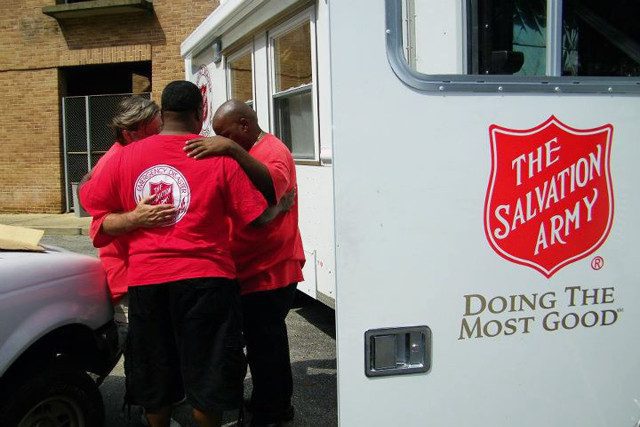
Hurricane Katrina struck southern areas of the U.S. 10 years ago this week, a devastating event in one of the most active and expensive hurricane seasons in American history. With an established presence across the states, The Salvation Army was uniquely positioned to support survivors during and immediately after the storms and for the years following. Today, The Salvation Army continues to be a source of hope, stability and service to residents of Mississippi and Louisiana.
The 2005 hurricane season spurred The Salvation Army’s largest emergency disaster response ever recorded in the U.S. Generous donations totalling $382 million were received to support survivors of the storms; all of these funds have been disbursed.
“This was an unprecedented relief effort and would not have been possible without a generous outpouring of support,” said Commissioner David Jeffrey, The Salvation Army’s U.S. national commander. “It has been an honor to serve the people of the Gulf Coast and partner with them to rebuild their vibrant communities.”
When the storms hit, Salvation Army emergency disaster workers and volunteers were on hand to deliver relief in the form of shelter, food and hydration, and emotional and spiritual care. A total of $157 million was spent on immediate response efforts, including:
-
178 canteen feeding units and 11 field kitchens brought in from across the country
-
More than 5.6 million hot meals and 8.2 million sandwiches, snacks and drinks served
-
178,313 cleaning kits and 235,229 food and grocery boxes distributed
-
282,000 emergency disaster assistance cases registered
-
Emotional and spiritual care provided for more than 275,000 individuals
-
Direct financial aid delivered, in the form of gift cards and housing/utility assistance
-
Provision of equipment and transportation for trained Salvation Army disaster personnel
-
Assistance to more than 2.6 million survivors in the affected region
The Salvation Army transitioned to long-term recovery in January 2006, allocating a further $225 million. These recovery services focused on case management, reconstruction and support for volunteer rebuild teams. Financial assistance programs also helped with home repair, job training and other initiatives to aid long-term recovery in communities.
Continuity of social services is critical to the ongoing health of local communities. Volunteers, staff and officers have worked to restore basic social service programs to the Gulf Coast—reopening homeless shelters, community centers, a rehabilitation center, children’s programs and church services.
As part of its overall recovery program in New Orleans, The Salvation Army initiated a community-based disaster recovery and economic resilience initiative called EnviRenew. Through this initiative, The Salvation Army supported new home construction, green home sustainability and technology, and eco-friendly energy programs in the hard hit Broadmoor, Riverview and St. Anthony’s neighborhoods. The program sparked a broader conversation about disaster resilience that culminated in a Resiliency Summit on the fifth anniversary of the disaster. Salvation Army facilities include:
-
A new Emergency Disaster Services centre in Jackson, featuring an emergency operations room, 17,000 square feet of warehouse space, a state-of-the-art amateur radio station and a vehicle yard for a fleet of specialized disaster equipment and vehicles.
-
Reopened corps (churches), social services programs, a homeless shelter, Adult Rehabilitation Center and family store in New Orleans.
-
A 52,000-square-foot Ray and Joan Kroc Corps Community Center in Biloxi to replace Salvation Army facilities lost during Hurricane Katrina, built on the site of one of the volunteer villages that The Salvation Army operated for Katrina aid workers.
-
Reopened corps, social services programs, a homeless shelter and family store in Gulfport, Pascagoula and Lucedale. The Salvation Army is presently acquiring property in Gulfport to develop a new Center of Hope housing program for the Mississippi Gulf Coast.
Because responding to catastrophic disasters takes a significant toll on responders, The Salvation Army has invested in local disaster programming and resiliency programming including training, equipment and infrastructure, emotional and spiritual care, and increased post-deployment follow up services for disaster workers. Additional community-based needs have been served through a variety of local programs, services and infrastructure projects.
“The Salvation Army is a long-term part of the community in the Gulf Coast, and everywhere in the United States where human need exists,” Jeffrey said. “After disasters large or small, personal or communal, people rely on us to help them get back on their feet. This is a responsibility we take extremely seriously. It is our mission and our calling.”
Report by IHQ Communications











